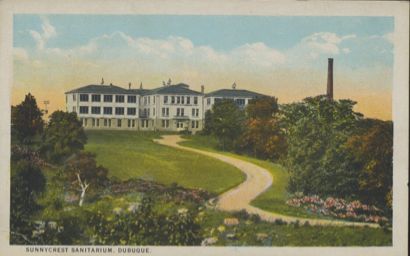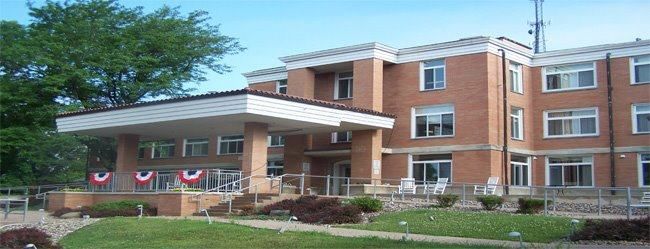Encyclopedia Dubuque
"Encyclopedia Dubuque is the online authority for all things Dubuque, written by the people who know the city best.”
Marshall Cohen—researcher and producer, CNN
Affiliated with the Local History Network of the State Historical Society of Iowa, and the Iowa Museum Association.
SUNNYCREST SANITORIUM: Difference between revisions
No edit summary |
No edit summary |
||
| Line 1: | Line 1: | ||
[[Image:sunnycrest2.jpg|left|thumb|250px|]]SUNNYCREST SANITORIUM. Sunnycrest was opened on August 13, 1921, as a means of | [[Image:sunnycrest2.jpg|left|thumb|250px|]]SUNNYCREST SANITORIUM. Sunnycrest was opened on August 13, 1921, as a means of treating patients with tuberculosis. (1) Once called "white plague" or "consumption," tuberculosis had afflicted civilization for hundreds of years. In 1906 a meeting was held in Dubuque to consider the establishment of a tent colony for patients. This followed the practice of the time of reducing exposure to the rest of the family by having the patient live in a small building or tent in yard. (2) | ||
In 19167 informational meetings with local charitable organizations and social clubs led to a public vote to approve a bond issue of $75,000 and a two mill levy for payment of bonds and maintenance of the building. (3) | |||
A twenty-seven acre site on the north end of town was purchased at $100.00 per acre. Prior to the start of construction, observations of similar facilities were made in Davenport, at the Oakdale institution in Iowa City, and at sites in Illinois and Wisconsin. Further work on the institution was halted until the end of [[WORLD WAR I]] at the request of the government. When work resumed, Anton Zwack was awarded the construction contract for $89,000. In most instances local firms were the low bidders for additional work. Dr. J. C. Painter was placed in charge of the hospital and served in the position for twenty-five years. | A twenty-seven acre site on the north end of town was purchased at $100.00 per acre. Prior to the start of construction, observations of similar facilities were made in Davenport, at the Oakdale institution in Iowa City, and at sites in Illinois and Wisconsin. Further work on the institution was halted until the end of [[WORLD WAR I]] at the request of the federal government. When work resumed, Anton Zwack was awarded the construction contract for $89,000. In most instances local firms were the low bidders for additional work. Dr. J. C. Painter was placed in charge of the hospital and served in the position for twenty-five years. (4) | ||
Prior to his retirement in 1957, Painter was able to announce the closing of the facility as a tuberculosis sanatorium. Once filled nearly to capacity, Sunnycrest had been nearly empty since [[WORLD WAR II]] and the development of better methods to cure the disease. The remaining patients were transferred to Oakdale Sanatorium near Iowa City. | Prior to his retirement in 1957, Painter was able to announce the closing of the facility as a tuberculosis sanatorium. Once filled nearly to capacity, Sunnycrest had been nearly empty since [[WORLD WAR II]] and the development of better methods to cure the disease. The remaining patients were transferred to Oakdale Sanatorium near Iowa City. (5) | ||
Within two and one-half years of its closing, the facility was reopened as the Dubuque County Nursing Home whose primary responsibility was the care of indigents. Those who could make partial payments were given secondary priority. Private patients were admitted with the understanding that they would move out if room for the other two categories of patients became unavailable. An addition to the facility was constructed in 1968; in 1976 the name of the facility was changed to Sunnycrest Manor. | Within two and one-half years of its closing, the facility was reopened as the Dubuque County Nursing Home whose primary responsibility was the care of indigents. Those who could make partial payments were given secondary priority. Private patients were admitted with the understanding that they would move out if room for the other two categories of patients became unavailable. An addition to the facility was constructed in 1968; in 1976 the name of the facility was changed to Sunnycrest Manor. (6) | ||
[[Image:san.jpg|left|thumb|350px|]] In 1980, Sunnycrest opened the Sunrise ICF/MR unit becoming one of the first community-based intermediate care facilities for persons with mental retardation. In 2001, Sunnycrest Manor implemented the “Home & Heart” program. The facility became Medicare certified to provide skilled nursing and rehabilitation services in May of 2005. Sunnycrest is also contracted with the Veterans Administration to provide long term care services for eligible veterans. | [[Image:san.jpg|left|thumb|350px|]] In 1980, Sunnycrest opened the Sunrise ICF/MR unit becoming one of the first community-based intermediate care facilities for persons with mental retardation. In 2001, Sunnycrest Manor implemented the “Home & Heart” program. The facility became Medicare certified to provide skilled nursing and rehabilitation services in May of 2005. Sunnycrest is also contracted with the Veterans Administration to provide long term care services for eligible veterans. (7) | ||
Care and services provided at Sunnycrest Manor are under the direction of the Dubuque County Board of Supervisors. The Dubuque County Hospital Board of Trustees are elected officials responsible for the maintenance and upkeep of Sunnycrest buildings, grounds and equipment. | Care and services provided at Sunnycrest Manor are under the direction of the Dubuque County Board of Supervisors. The Dubuque County Hospital Board of Trustees are elected officials responsible for the maintenance and upkeep of Sunnycrest buildings, grounds and equipment. (8) | ||
--- | --- | ||
| Line 17: | Line 17: | ||
Source: | Source: | ||
www.dubuquecounty.org/SunnycrestManor/tabid/137/Default.aspx | 1. Kruse, Len. "My Old Dubuque," Dubuque, Iowa: Center for Dubuque History, Loras College, 2000, p. 56 | ||
2. Ibid. | |||
3. Ibid. | |||
4. www.dubuquecounty.org/SunnycrestManor/tabid/137/Default.aspx | |||
5. Ibid. | |||
6. Ibid. | |||
7. Ibid. | |||
8. Ibid. | |||
[[Category: Health Care]] | [[Category: Health Care]] | ||
Revision as of 02:13, 20 November 2013
SUNNYCREST SANITORIUM. Sunnycrest was opened on August 13, 1921, as a means of treating patients with tuberculosis. (1) Once called "white plague" or "consumption," tuberculosis had afflicted civilization for hundreds of years. In 1906 a meeting was held in Dubuque to consider the establishment of a tent colony for patients. This followed the practice of the time of reducing exposure to the rest of the family by having the patient live in a small building or tent in yard. (2)
In 19167 informational meetings with local charitable organizations and social clubs led to a public vote to approve a bond issue of $75,000 and a two mill levy for payment of bonds and maintenance of the building. (3)
A twenty-seven acre site on the north end of town was purchased at $100.00 per acre. Prior to the start of construction, observations of similar facilities were made in Davenport, at the Oakdale institution in Iowa City, and at sites in Illinois and Wisconsin. Further work on the institution was halted until the end of WORLD WAR I at the request of the federal government. When work resumed, Anton Zwack was awarded the construction contract for $89,000. In most instances local firms were the low bidders for additional work. Dr. J. C. Painter was placed in charge of the hospital and served in the position for twenty-five years. (4)
Prior to his retirement in 1957, Painter was able to announce the closing of the facility as a tuberculosis sanatorium. Once filled nearly to capacity, Sunnycrest had been nearly empty since WORLD WAR II and the development of better methods to cure the disease. The remaining patients were transferred to Oakdale Sanatorium near Iowa City. (5)
Within two and one-half years of its closing, the facility was reopened as the Dubuque County Nursing Home whose primary responsibility was the care of indigents. Those who could make partial payments were given secondary priority. Private patients were admitted with the understanding that they would move out if room for the other two categories of patients became unavailable. An addition to the facility was constructed in 1968; in 1976 the name of the facility was changed to Sunnycrest Manor. (6)
In 1980, Sunnycrest opened the Sunrise ICF/MR unit becoming one of the first community-based intermediate care facilities for persons with mental retardation. In 2001, Sunnycrest Manor implemented the “Home & Heart” program. The facility became Medicare certified to provide skilled nursing and rehabilitation services in May of 2005. Sunnycrest is also contracted with the Veterans Administration to provide long term care services for eligible veterans. (7)
Care and services provided at Sunnycrest Manor are under the direction of the Dubuque County Board of Supervisors. The Dubuque County Hospital Board of Trustees are elected officials responsible for the maintenance and upkeep of Sunnycrest buildings, grounds and equipment. (8)
---
Source:
1. Kruse, Len. "My Old Dubuque," Dubuque, Iowa: Center for Dubuque History, Loras College, 2000, p. 56
2. Ibid.
3. Ibid.
4. www.dubuquecounty.org/SunnycrestManor/tabid/137/Default.aspx
5. Ibid.
6. Ibid.
7. Ibid.
8. Ibid.



